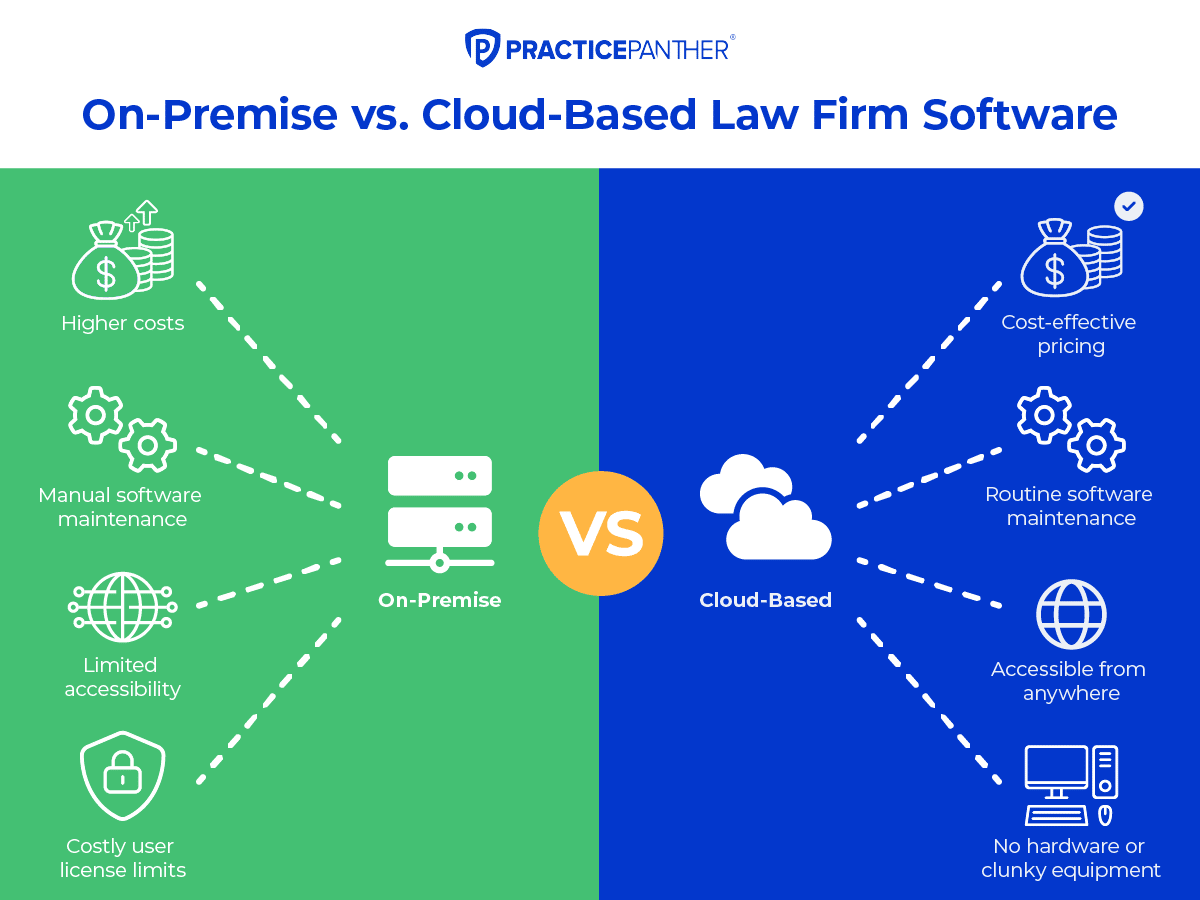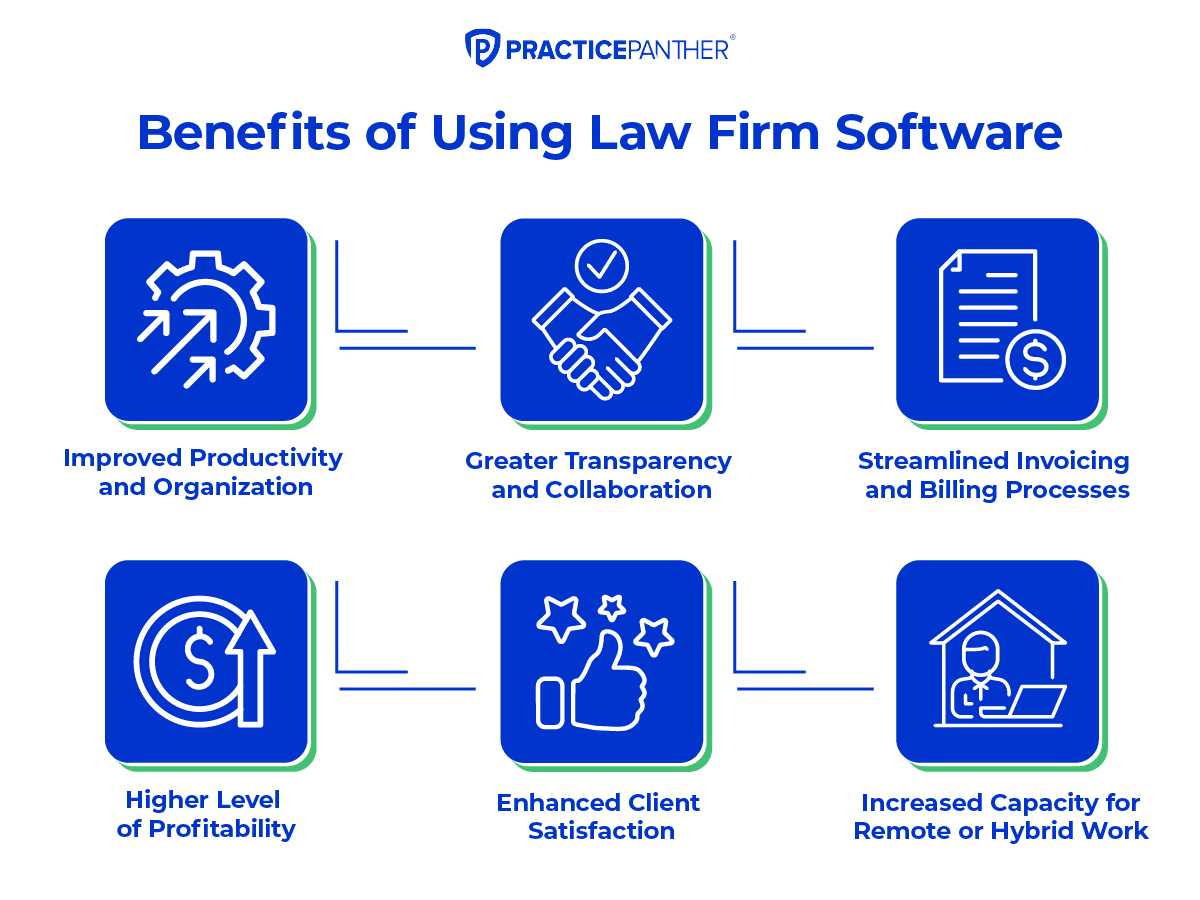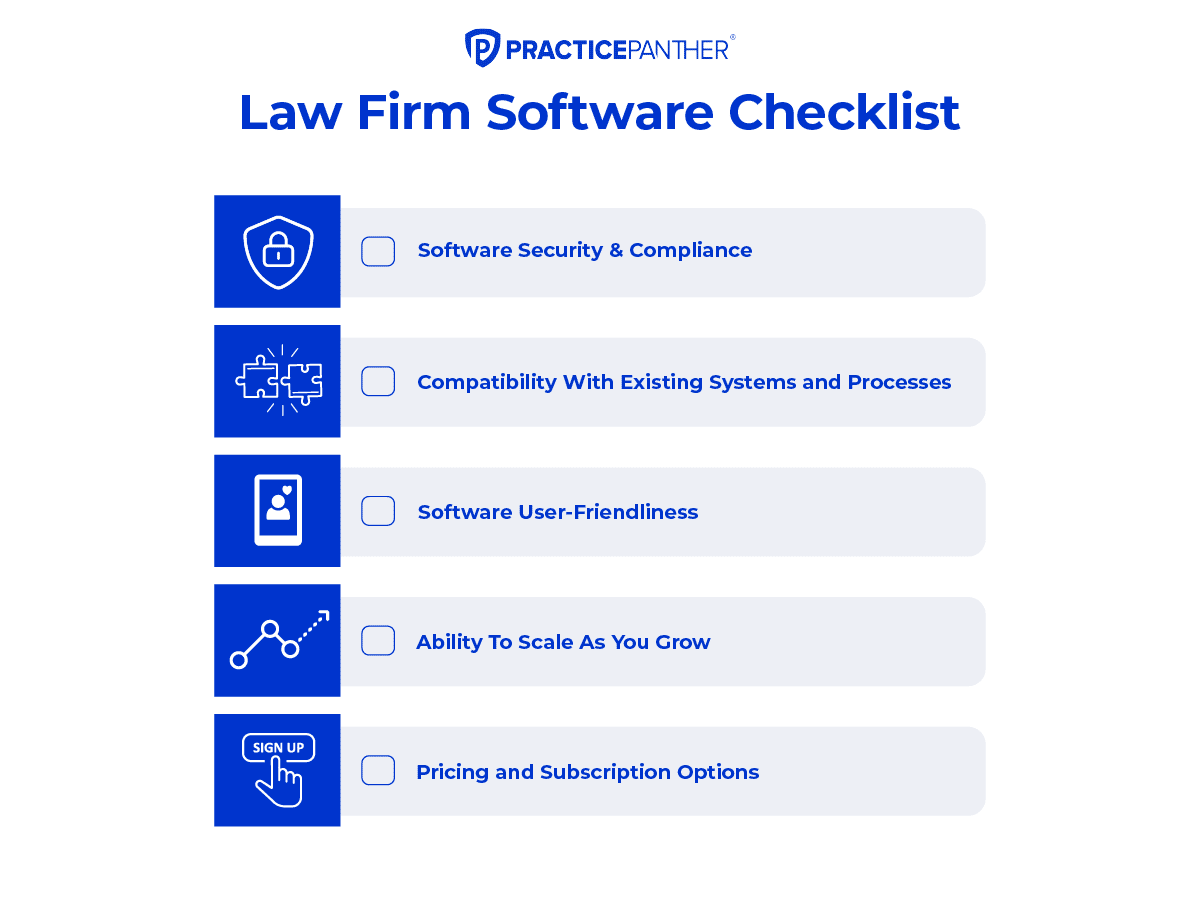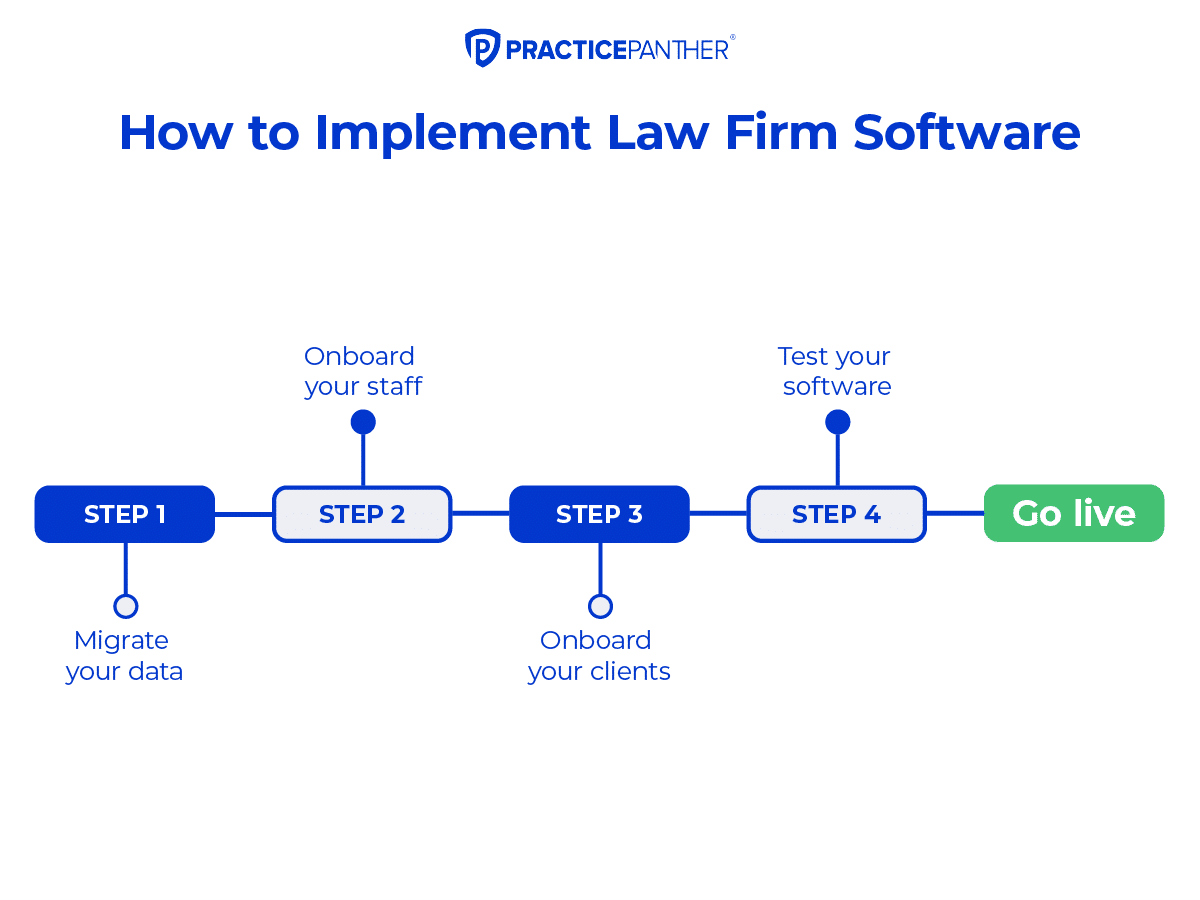

Effectively managing your law firm’s operations can often be a balancing act. Whether you’re a solo practitioner or a lawyer at a large law firm, you are likely involved in various aspects of your practice. From document management and case management to billing and time tracking, keeping track of so many tasks and details can be challenging.
While not impossible, manually keeping track of multiple cases and deadlines can lead to stacks of paperwork, gaps in communication, and clerical errors. These inefficiencies can lead to unsatisfied clients and financial losses. Because of these challenges, many law firms are looking for specialized software to help avoid headaches and provide a better experience for clients.
Law firm software provides myriad benefits to firms, including improved collaboration between teams, enhanced security for client information, and more effective case management. In a Bloomberg Law 2022 survey of 190 legal professionals, 88% of the respondents agreed that legal technology is essential to their ability to meet clients’ demands, while 86% agreed legal tech helps improve the legal services they provide. Legal technology, such as law firm software, can help automate repetitive or administrative tasks to free up time and resources that can be dedicated to focusing on clients.
Whether your firm is new to law firm software or looking to upgrade its existing software, choosing the right software for your firm can be overwhelming. That’s why we put together this buyer’s guide to help you understand the different types of law firm software and what to look for. By the end of this guide, you will have all the information you need to make an informed decision that guarantees satisfaction with your choice. Let’s dive in!
Law firm software is a type of software that helps law firms manage their business operations, case files, and daily workflows more efficiently. Sophisticated law firm software can help firms streamline everything from document management and data security to Client Relationship Management (CRM) and client experience.
The idea isn’t to make your firm overly complicated with new, complex technology that requires an IT department to manage; it’s to streamline your day-to-day functions, so you can focus on more important things—like practicing law.
Now that you have a solid understanding of what legal software is and its purpose, let’s explore two common types of law firm software you will encounter in your search: on-premise vs. cloud-based software. In this section, we will highlight the pros and cons of both deployment
methods to help you better understand which one fits your firm’s needs.

On-premise software is installed directly on the law firm’s computers and local network. When a user needs to access the software, they will need to use a computer that has the software locally installed and is connected to the local network.
In 2018, Gartner predicted the “death of on-premise software” by 2025. However, the COVID-19 pandemic in 2020 became the catalyst for this trend. As businesses everywhere were forced to adapt to a remote workforce overnight, the difficulty of accessing data and operating remotely exposed the limitations of on-premise data centers and hardware.
Despite this shift, there are still benefits to using on-premise software. Let’s take a look at the pros and cons.
Cloud-based software is hosted on third-party servers and can be accessed over the internet. Users who want to access the software can use any internet-enabled device, such as a laptop, phone, or tablet, using their username and password. Some cloud-based solutions also offer mobile apps, giving users the full power of the software in a mobile-optimized format.
The use of cloud-based software in the legal industry has grown significantly, in no small part due to COVID-19 and the shift to remote work. In the 2022 ABA Legal Technology Survey Report, 70% of lawyers surveyed confirmed using cloud-based software at their firm. Of these, 84% of solo practitioners reported cloud usage, followed by 75% of small and medium-sized law firms.
Let’s take a look at the pros and cons of cloud-based software for law firms.
We just gave you the low-down on cloud-based vs. on-premise software. Now let’s get into the different types of software law firms have to choose from. In this section, we’ll break down each type of legal software and its key features. Armed with this information, you will be able to confidently select the software that fits your needs and provides the most significant benefit to your firm.
Firms that choose legal management software are looking for a comprehensive solution that can tackle a multitude of tasks. Essentially, they are looking for all-in-one software to streamline all their processes into a centralized system.
Practice management software helps firms automate administrative and financial tasks, like appointment scheduling, billing and invoicing, client relationship management, and more. It’s an excellent choice for larger firms with a lot to keep track of and small firms or solo practitioners where one person may be unable to do everything.
Legal case management software focuses on tracking all the specific details, deadlines, and progress of individual cases. Common features include document management, contact management, and automated workflows for routine processes like client intake.
A legal document management system helps firms manage the collection, storage, organization, and retrieval of their documents. Advanced features include document version control, remote collaboration, and template libraries, to name a few.
Document management is vital to keeping the information you need easily accessible while securing your clients’ confidential information safe. This software also helps your law firm comply with data security laws and regulations.
E-signature software enables parties to electronically sign legally-binding documents from any location. This software eliminates the need for manual printing, scanning, and mailing legal documents, reducing the time wasted going back and forth and following up with third parties and clients for document signatures.
Additionally, a robust eSignature solution will use authentication to verify the signer’s identity and encryption to secure the document’s integrity. With the right eSignature software, a firm can keep cases moving forward smoothly and securely.
Scheduling and calendaring software is designed to help firms manage schedules and case deadlines effectively. This software allows lawyers and legal professionals to schedule appointments, track court dates, and keep tabs on other important dates. Scheduling and calendaring software can solve many headaches for teams that struggle to coordinate their schedules.
Legal calendaring software is a more comprehensive alternative to docketing software, offering a way to centralize day-to-day tasks, events, appointments, and deadlines in addition to case-related dates and deadlines the typical docketing software can track. The main benefits of this software include improved collaboration between teams, increased organization, and improved time management— all of which result in better service to your clients.
Legal billing and payments software helps firms automate their manual billing process to reduce time spent on administrative tasks like generating invoices and following up on payments. This software helps firms view their billing and payment activities at a glance, providing a bird’s eye view of where the firm can improve its financial performance and where they excel. Additionally, legal payments software helps firms process payments in compliance with ABA and IOLTA rules and receive payments up to 70% faster.
Law firm financial management takes time, effort, and understanding. Many firms hire a bookkeeper and work with an accounting firm to ensure everything from billing to taxes is handled correctly. When firms use legal accounting & bookkeeping software, law firms can more easily provide information to their accounting professionals come audit season.
Trust accounting is a legal practice where the law firm manages its client’s funds in a secure account. This account stores client funds that have not yet been used but are intended for legal fees. Law firms must take precautions to keep the money separate from the law firm’s funds and use it only for its intended purpose. Trust accounting software can assist you in maintaining accurate financial records, effective account management, and compliance with state bar laws and regulations.
Attorney-client relationship management is a massive part of the success of any law firm. When a firm takes on a new client, they need to know all the pertinent details about the client and their case. Without CRM software, it can be easy to overlook information about a client that could be very valuable to the case. This software helps law firms automate client intake forms and onboarding to ensure that all the critical questions are asked.
The right time-tracking software can help law firms track billable hours and expenses accurately across every case, making it easier to bill clients without error. Automating time and expense tracking saves your team time on administrative tasks and helps you recover lost revenue from unbilled tasks discovered through custom reporting features.
Real-time data from legal management reporting and insights software helps law firms understand what is working and what might need to be adjusted. It can show whether there has been a reduction in client numbers, a shift in the types of cases taken, or other trends in performance. With this information, law firms can make informed decisions on pricing strategy, service offerings, client service, and more.
Attorneys and legal professionals interact with various external parties, including expert witnesses, their local court system, police, and other types of law enforcement. These routine interactions require tracking all the information about these interactions in a centralized location. Legal contact management software helps law firms keep track of contact information and communications with external parties. With every interaction logged in one place, contact and matter management software makes it easier for law firms to find the information they need and reduces the chances of overlooking a critical interaction.
Task management software helps law firm teams stay on track to meet deadlines by organizing daily schedules and to-do lists into one user-friendly dashboard. This software helps lawyers see their pending tasks at a glance to prioritize their day and get more done. By meeting deadlines and ensuring tasks aren’t overlooked, lawyers can build trust and strengthen their client relationships.
We’ve shown you the various types of law firm software available on the market and shared some technical knowledge you’ll need when evaluating different solutions. Now let’s get to the good stuff: the real reason so many practices are adopting a software solution in the first place. In this section, we’ll share six ways (although there are many more) law firm software can enhance your team’s performance and help you better serve your clients.

Law firm software helps automate routine administrative tasks and improve your team’s productivity, saving you up to eight hours a week. Automating areas such as scheduling, time tracking, and file organization gives your team time back in their day that can be spent on their cases and developing client relationships.
Coordinating deadlines and tasks between team members can be a challenging feat. Law firm software can improve your team’s workflow by providing greater visibility into task status, team member availability, and upcoming deadlines.
Team members can hold themselves and each other accountable, communicate using real-time data, and identify any potential setbacks before they happen. This visibility is especially important for teams with remote employees or multiple offices.
Let’s be honest. Time tracking, expense reports, invoicing, and billing are probably the least glamorous parts of practicing law and the most time-consuming. Law firm software can ease this burden by reducing payment times and increasing your cash flow. From the client-facing side, you will be able to provide a better client experience with consistent and on-time billing.
We’ve already established that legal software automates your administrative workload. But what does this mean for your firm’s bottom line? Let’s look at client intake as an example.
Client intake is one of the most critical activities to the growth and profitability of your firm. However, it can also be a bottleneck if there are delays in your client’s schedule and they can’t fill out an intake form in person.
Law firm software allows you to automate the process with online client intake forms that your clients can access anytime from any location. This feature lets you quickly qualify prospective clients and take on new business.
This is just one of many ways law firm software increases your profitability by reducing the amount of time you or your team spends on non-billable tasks.
We’ve talked a lot about the improvements you’ll see in your internal processes when you implement law firm software. These improvements won’t go unnoticed by your clients.
Law practice management software helps firms provide a more efficient, frictionless client experience that builds a positive reputation for your firm. When your clients are satisfied with their experience, they are more likely to come back to you for repeat business and recommend your services to others.
Remote work is much more common (and in demand) than it used to be. From an employer’s perspective, developing remote work capabilities is critical for employee recruitment and retention.
With cloud-based practice management software, firms can better support remote and hybrid working arrangements to provide flexibility for existing employees and remain competitive with prospective employees.
As you’ve seen, legal software provides a slew of benefits that can help improve your practice’s financial performance, streamline collaboration and workflows, and help you provide a superior client experience.
You might be wondering — when is the right time to invest in law firm software? Law firm software can be a sizable investment, and timing can make all the difference when it comes to realizing its full potential and seeing a return on your investment. In this section, we’ll walk you through how to determine whether your practice is ready for law firm software.
The short answer to whether it is the right time for a firm to invest in software would be that it depends. Ultimately, the firm’s specific circumstances and needs are what matters most.
Once you’ve determined that your firm is ready to invest in a software program, it’s important to choose the right solution.
Choosing the right legal practice management software boils down to what will satisfy your firm’s needs the most. Sure, there are plenty of options—but you want your money to bring in the best value.
Here are the most critical steps for any firm to follow when choosing law practice management software.
Before you start your search for a software solution, you need to determine the needs and goals of your firm. Ask yourself, “What tasks and functions should the software perform to benefit the firm?”
Think about specific pain points in your current workflow that software can resolve. Maybe your firm needs better document management or help to handle scheduling conflicts. Whatever the case, make sure you know what features are essential for your firm.
Consider the specific practice areas your firm services and whether your software will need to offer special capabilities. For example, if your firm specializes in estate planning, you will need software with trust accounting capabilities.
Gather data on how many cases your firm handles and the number of clients you serve to determine the level of automation your firm needs. Small firms that cater to a limited number of clients might not need the same software features as larger firms with a larger client base.
Once you have a clearer picture of what you need from your legal software, you’re ready to start your search.
Next, you must determine what your firm can and should spend on software. You should evaluate the firm’s financial standing, growth rate, and software’s importance in realizing your long-term goals.
As mentioned previously, it’s crucial to account for the total cost of the software and not just the initial cost. Consider long-term costs like subscription fees and upgrades since these will increase the total cost of your software over time.
Determine whether your firm wants to make a one-time purchase or several payments over time, and budget accordingly. Remember that software is an investment that will benefit your firm in the long run through increased efficiency and profitability.
Now, you’re ready to create a list of software options that fit your needs and budget. Research each option’s features and capabilities and compare the price and terms each software option offers. Consider the technical requirements and whether the software is compatible with current systems.
With your list in hand, look for customer reviews and ratings written by actual software users on independent sites where reviews will not be biased. Read through positive and negative reviews, keeping the reviewer’s needs and context in mind. These reviews can help you get a more accurate understanding of a software’s strengths and weaknesses.
Additionally, it can be helpful to reach out to firms and legal professionals currently using the software to get additional feedback.
Look for free trials or demos of the software you are evaluating; these are great ways to experience the software first-hand and see if it fits your needs and workflow.
Use the demo period to ask questions or address concerns with the software vendor. This can also help you get a feel for how the software provider treats their customers and the level of support you can expect.
If you followed the steps above, you’ve probably narrowed your list down to a few solid options for law practice management software. We’ve put together this checklist to help you evaluate your options and make an informed decision.

Law firms must ensure their practice management software is compliant with security and privacy standards. Your firm has access to a lot of confidential information and sensitive data every day. This includes information clients provide about themselves and their finances and information about your firm and its proprietary practices.
Data breaches and unauthorized access could cause harm to clients and to the firm itself, so minimizing the risk is extremely important. Make sure your solution has security measures in place, like two-factor authentication, to prevent unauthorized access to your account.
Additionally, you must ensure your software of choice is legally compliant with HIPAA and applicable state bar rules.
Make sure the software you choose is compatible with your current systems and practices. If the software does not work with your existing technology stack, that compatibility issue could be very costly.
If you already use law firm software, think through your current workflow and account for all the information you rely on your software to manage. Make sure your new solution can provide you with a similar or improved alternative. A smooth transition from one software to another is critical to reducing disruptions in your workflow.
Software providers should enable automatic data transfer from your existing software to your new software to mitigate the risk of errors or data loss. Some software providers offer migration. In this case, it’s essential to understand the service’s cost and expected completion timeline.
Evaluate the solutions you are considering for user-friendliness. Your legal software should be easy to navigate and intuitive to use. Your goal should be to choose a solution your team will be able to learn quickly, regardless of how tech-savvy they are.
Research the training and support offered by the software provider to ensure your firm will be supported throughout the transition. A steep learning curve without adequate support can not only cause frustration among your team but can result in a lengthy training period.
Your software solution needs to meet your needs throughout every stage of your firm’s growth so that you don’t have to switch to a new solution as you scale your firm. By looking ahead and ensuring your software can accommodate growth, you can protect the financial investment you’re making.
Look for software that offers scalability in terms of the number of users, complexity of features, and availability of data storage. Your software provider should also have reliable technical support to guide you through any technical issues that arise as your firm continues to grow.
At the end of the day, you want to choose a solution that fits your budget without sacrificing functionality. When evaluating the price point of software, think about the total price. This includes the cost of hardware, software licensing fees, time spent on implementation and training, and ongoing maintenance.
Consider the type of subscription model you prefer, whether it’s monthly, annual, or a one-time fee, and choose the one that best fits your needs. Look for flexibility in pricing, allowing you to pay for only the features you need without paying for any you don’t.
You’ve made it through the research process and decided on the software that works best for you. Congratulations! Now it’s time to implement your law practice management software. Here’s what you need to consider to get your software set up and running as quickly as possible.
Implementing new software can be seamless for law firms with the proper planning, training, and testing. If you follow the steps outlined above, you’ll be one step closer to ensuring a smooth transition for your firm.
 Summary
SummaryYou’ve reached the end of our Buyer’s Guide to Law Firm Software. By now, you should have all the information you need to decide on law firm software confidently.
Whether you’re investing in software for the first time or switching to a new solution, we hope we have provided you with valuable insights to find the perfect solution for your firm.
Here’s a quick recap of the main takeaways from this guide:
Is your law firm ready to take the next step and explore software solutions that can give you and your team members increased efficiency and improve your client experience?
PracticePanther is the leading legal practice management software for firms of all sizes, offering robust features that can help you streamline your practice and scale your software as you grow.
Here’s why tens of thousands of legal professionals trust our all-in-one platform to manage their complex and fast-moving cases without a hitch.
PracticePanther is here to make your law office operate more smoothly than ever. To find out more, contact PracticePanther today for a product demo, or start a free trial.